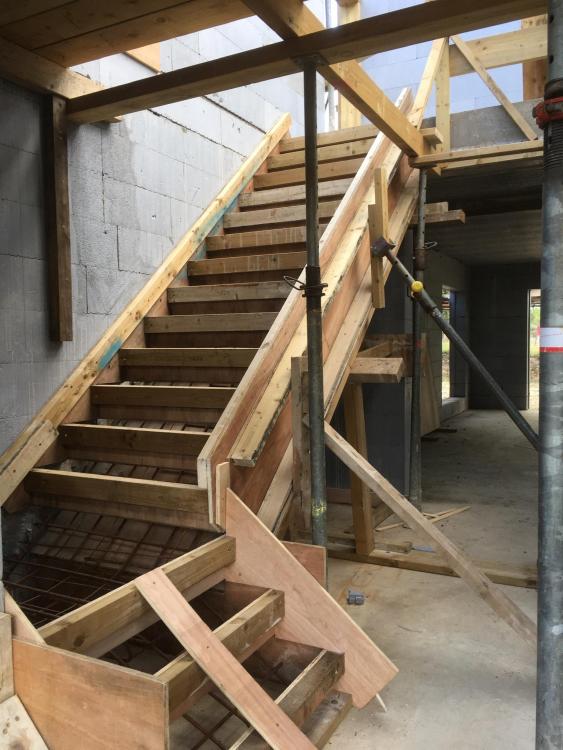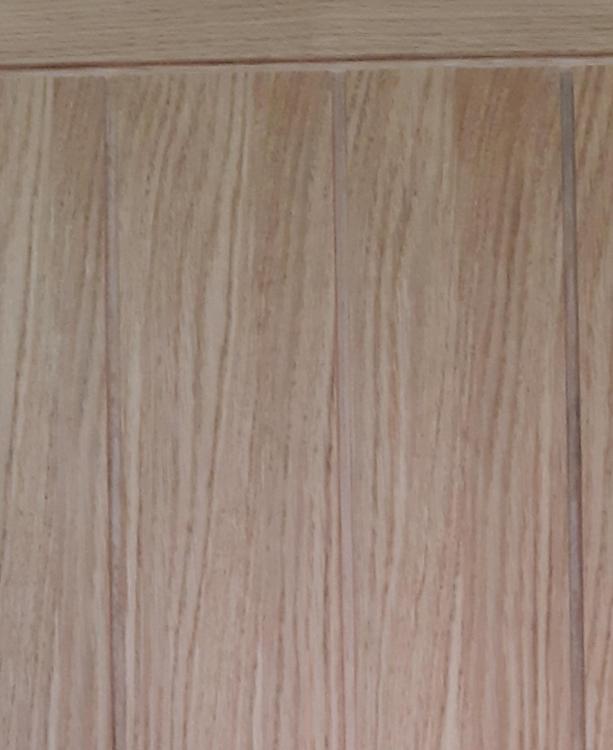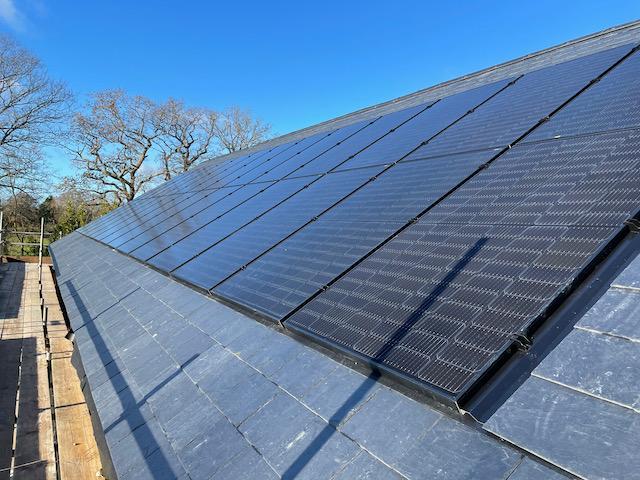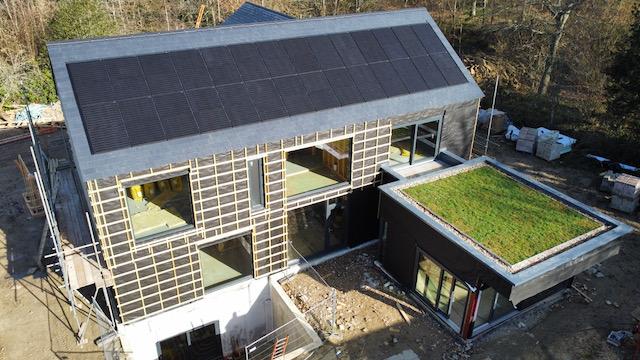Leaderboard
Popular Content
Showing content with the highest reputation on 02/27/22 in all areas
-
Well our builder was a crook and we lost a lot of money. Happened just at first lockdown. Luckily enough that meant working from home for 18months so de camped to the site and built it myself and skived work as much as possible. Doing video calls whilst in a building with no roof in the rain.... Said wifi was too slow so did voice only lol. 2years on and next week we are getting BC in for final sign off. Looking back, I now know the original quote was miles too low, if we had paid a proper builder it would have cost a lot more than we have spent even allowing for the money we lost from the original crook. Oh and we were renting locally, they decided to sell and wanted it empty so we moved into the house in Oct 2020 with no heating, no internal walls, no plasterboard, temp stairs, temp electrics and a site toilet.... Didn't even have any cladding on the outside, so it looked like a giant purple quality street with the vapour wrap on. That was a Grim winter huddled around a couple of electric radiators. But, and for us this was critical, we never fell out of love with the site. 2 acres of woodland, our house in the middle and a 10 min walk to the centre of looe and the beach. Oh, and access is via a very narrow and steep road, I can just, and I mean just, squeeze my Toyota hilux onto site. So everything had to be brought in on that. I will never forget putting in 240 sheets of 18mm OSB on my own. And plasterboard, my god the fireproof stuff is heavy for 1 person. 140mm woodfibre external insulation, also bloody heavy. Never had any scaffolding on site, as I was on my own I worked of a decorators platform, dodgy as hell but never fell off! Never had any skips, cant get em on site lol. And as of last week told work I am taking early retirement at the end of this year. I can afford it, just. Retiring poor, but just affordable. Going to enjoy the building and location this summer for the first time, all worth it! I can certainly say, without this site I wouldnt have known half the stuff I do now and sharing pain is great ?4 points
-
Money spent on a proper survey will allow you to sleep at night. Nowt worse than not knowing....2 points
-
As per previous two comments the staggered stud wall thats decoupled from each other offers the best gains from my research but unless your washer shakes around a lot on the floor or pressed back against the wall, most of it will be airbourne sound so the doors a weakness. Look at adding something like rockwool rw45 between studs and then soundblock board. You could decouple the board to stud using green glue tape or adhesive sealant. Drop seal on the door if you dont have mvhr. Sound cant travel through a vacuum but we cant live that way so its minimising impact and airbourne2 points
-
2 points
-
Notes from video description and nuggets buried in comment replies: SCOP 2.99; "very small radiators, no cavity insulation" (but some attention to air tightness I suspect). "Vaillant Arotherm Plus. The load is about 6 kW … 22mm pipe." (He thinks the Vaillant HPs are much better than Mitsubishi, but more expensive.) "It was a pretty much consistent 21c internal temperature internally all week." "Weather compensated … curve selected is set for around 55c at -1." "I think once this has sensible radiators the SCOP will be more like 5." "Run 24/7 … set back overnight at 18c … does not turn off but lowers flow temp." "Electrical consumption in Dec … 580 kWh" Any TRVs left on max, ASHP modulates the flow temp down to what's required to maintain room temp. "I have not, nor will not state that insulation isn't the first most important step. By releasing this video I am not saying technology first. … We did not insulate first as this is not a house. This is a showroom. The heat pump will return before insulation and insulation does not fill the showroom." Sorry if you've seen this before. Sk8rboi has some other good content in the channel.1 point
-
Looked in to it but discounted as cost comes in above precast slabs. Also, spans aren't nearly as good as precast (precast use tensioned cables) Precast slabs are installed in less than a day, you just need to get them measured up and ordered in good time.1 point
-
Single storey extension I would go for a raft every day of the week - piling will be a huge effort for a small section of building. I’d also consider the whole lot going if you’re having to do that for such a small part - why the desire to rebuild what is there..?1 point
-
They’ve used PU foam and that’s a rigid insulation so when the steel does deflect only operational issues will be experienced. That’s pretty much not done anymore and compriband is used, if they include it in installation cost or an extra. If client doesn’t pay for it not much they can do but use PU foam. I suspect they will be difficult to slide at some point.1 point
-
You can’t really compete with point 1. Unless you are going to redevelop it, the value to you of this house is not its redevelopment value. So ignore that consideration. Point 2 is also irrelevant. You are allowed to reduce your offer after a survey; by how much is down to relative bargaining strength and how obvious the issues “discovered” in the survey were before the survey. Point 3 also irrelevant.1 point
-
Doubt you’ll get a surveyor to ignore that big horizontal crack - that could well be subsidence from leaking drains below the concrete slab all round the house. I’ve seen whole sections disappear and the concrete acting like a bridge ..! If you’re talking about underpinning then you will need deep pockets as it could be £20-30k and you’re already bidding over the odds. Working in that “tunnel” would be entirely manual and you would have to protect the the other side from subsiding when digging so it may need to be done from the inside. Not one I would be taking on unless it was £50k under the average for the area as what else needs doing if that’s the mess you can see ..?1 point
-
If you are buying, then surely your offer is subject to survey? Get a survey from a decent surveyor and ask him to focus on the issues that really matter: subsidence and damp and wood rot. Then see what his survey says and then decide. A little bit of settlement won’t stop you from getting insurance. Subsidence might, and that is when it becomes problematic to sell. Alternatively, if it is fixable with a a few linear metres bit of underpinning or helifixing, then it’s not such a big deal, and you can get a SE to issue a certificate of structural adequacy to enable you to get insurance. Armed with a survey, you can get a quote for the work and the certificate and go back to the vendor and ask for a discount to account for all of that.1 point
-
There is no way that you want them to do work, you need the relationship and control, they will be advised not to do work, just sell. they may be under pressure as once probate is granted IHT cuts in and the revenue will want money the cracks will be very off putting to home buyers and mortgage issues will ensue. what crack are they talking about, there are lots of cracks1 point
-
Not me but we saw a lot of different systems used in Belgium when we lived there. One I remember used thin concrete beams about 30mm deep with rebar pyramids sticking out of the top. These were laid side by side touching each other like the metal sheets of Metfloor. Then mesh was laid on top and concrete poured to complete the slab. Their big self buildshow called Batibouw had companies selling systems which I think were intended to be erected by hand without a crane. We ended up using beam & block for our first floor. The beam company provided metal clips for attaching battens to the underside of the beams. Plasterboard was fixed to the battens. This gives a void deep enough for wires in any direction but waste pipes can only be run parallel with the beams. If you need to run pipes the other direction you need to drop the plasterboard lower somehow. Wouldn't be hard. On top we have insulation and screed with UFH. We love the solid feel a concrete floor gives the house. Never had to yell at my kids to stop jumping about upstairs.1 point
-
1 point
-
I've looked at my ecodan a few times and the conclusion I've come to is that the values are made up so I don't look at them anymore.1 point
-
LG are at the top end of panels so they weren't cheap but they degrade slower than something like the JA Solar panels and have guaranteed performance after a certain number of years. (sorry I forget the actual figures!)1 point
-
Ask them for the spec on the gates and ask if they do a battery backup version. I’ve seen this before and you basically run a 1A battery charger on the gates (or even solar) and then use the batteries for the grunt as they only need the power to open and close. Lots of farm gates have similar setups due to exactly this reason.1 point
-
We built a 120m2 basement in Berkshire clay/gravel/chalk. Ground conditions were good so no de-watering required, was able to just batter back sides of excavation. Went down 3.5m and ffl was about 750mm above that. We looked at Glatthar, friends of ours building in the water near the thames used them, very happy, but they are not cheap. You're paying for pre-cast concrete panels to be shipped from Germany to UK vs pouring them in situ using concrete from a plant a few miles away from you. We just used a local groundworker firm who did sub-surface structures like parking garages etc. They did shuttered concrete with a warrantied SIKA waterproofing system - we did not require external tanking or internal membrane. That whole package - demo & removal of existing, excavation & muck away, casting of basement, backfill and in ground services (fouls, rainwater, water & ducts for gas) came to £120k back in 2016. Glatthar wanted more than that just for the basement itself. A basement is just an underground concrete box at the end of the day, the SE will design it and any number of firms can construct it to the required standard. If you have good access and are not tunnelling under an existing building then that simplifies life. The dewatering will be expensive, as will the piling and shuttering though.1 point
-
GSE trays and the panels are LG 375W Mono NeonH Black E6. the supplier is a little bit of a sore point as we used Enhabit for our M&E design and they supplied the components for our Solar PV, MVHR and ASHP/DHW. But they have recently been bought out by/merged with Green Building Store and no longer offer ASHP or Solar PV so I have been left with incomplete installations. But that's life I guess and I can find someone else to finish the job.1 point
-
I’ve been a carpenter/builder my whole life and this has been hard, living in a caravan has been hell. It’s demoralising to wake up, Graft all day, then go back to the caravan without leaving site for days on end. Still- I’m ploughing through it. would I do it again? Not a chance! I won’t go back to building because simply I can’t be arsed with all the paperwork and stress- and I’m not fussed about making money. what I wouldn’t mind is building other peoples ‘self builds’- Labour only and site management. The passiv side of it has been fascinating.1 point
-
We're more of a 'damn I wish I knew then what I know now'. We'd handle things very differently from the start if we did it again. With the current build there's lots that we could have done better. But at our time of life, we're not starting another one..... Simon1 point
-
Arch too close to corner to be viable, flank wall to passage lots of cracks, looks like moving but could be wind, physical damage, poor foundations side wall of house , crack at low level looks like push from inside, chipboard floor suspected but needs investigations1 point
-
Not much to add either but i would be more looking at the 7th image, where the crack runs horizontally and appears to widen to one end.1 point
-
We have XL Joinery internal Oak doors with grooves a bit like that, and oiled with Osmo door oil there is no difference in colour between the door and the grooves.1 point
-
OK I have an update, and I guess a confession. I bottled out when it came to contacting the door supplier. But it's not all bad news. I had a go at sanding the grooves and I think it looks OK. I know I'll have to toughen up and question when things aren't right and I'll try in future. But I can live with this, my doors look pretty good actually. When I oil next time, think I'll just roller the surface and not in the grooves, should avoid the orange stripe effect!1 point
-
I’m not a SE, so no idea really. But based on my own experience of subsidence in a house of a similar age and style, I think that apart from where that tunnel is, none of this looks too serious. Most of your cracks (apart from that tunnel) appear to be close to windows or door arches. It is more likely that the lintels have rotted or given way slightly, or just shrunk a bit, as lintels in 1920s and 1930s houses were made of wood, which obviously isn’ta great material for a lintel when it is c. 100 years old. it might be a case of removing the render, then use helibars to stitch the underlying brick work together and possibly also replace the lintels, though this isn’t always necessary. My SE designed a fix like this for the front facade of my 1930s semi when we discovered the brickwork had cracked around the windows after removing the render. As for the tunnel, that doesn’t look great. But could look worse than it is!1 point
-
Oh yes! We are in a caravan at the moment and have endured Eunice, Franklin and Gertrude. The only blessing is that they dry the mud up! But being as the month of February is known, locally, as "February Fill Dyke - be it black or be it white", the dried mud does not last long1 point
-
And spent the winter of the "beast from the East" in a static caravan......... Most of us say "never again" and then after a couple of years, the itch comes back.1 point
-
And all of us still building have, probably, built through the wettest winter on record, Brexit and Covid!1 point
-
My friend has finally agreed to lend me one of his 15 ton machines Massive shortage of plant to buy or hire round here I was quite surprised How things have come On Last time (5 years ago) I dug and my wife bravely stood in the trenches with a staff and a laser detector This time I will simplify feed the cad drawing into the excavator and dig I’m hoping this will quicken things up as j only have the machine for five days Though last time I was digging in November While the more experienced can dig under lights I was pretty hopeless as soon as it was dark Hope to get started on the 14th ?1 point
-
And the rumbling noise through the floor. Which of the washing machine noises annoys you most? The high pitched swish swish, the banging or humming of the spinner, or a rumbling through the floor...etc. ? You need soft absorbent construction as well as density...and this is not all possible in a thin wall. Plus cut a slice out of the floor under the wall to stop physical transfer under it. Or invest in a quiet washing machine.1 point
-
It's a tough ask. But I reckon there are a couple of strategies you can use. You can get a 50mm stud wall built up for about 54db reduction using a type of sound board resulting in a total wall thickness of about 95-100mm. Buildup is sound plasterboard/50mm stud with either air or mineral wall insulation/acoustic board (30mm), then you've got either a plaster skim/tape & joint over those. One of the problems is your studs which should ideally be staggered to reduce sound transfer. If you left your wall at 140 and used stagger 38 x 89 studs with zigzag acoustic insulation you'd probalby be fine. Another strategy is slightly more complex, which would be to build your stud wall with sound plasterboard and some acoustic mineral wall insulation and then measure your sound spectrum with the washing machine and other appliance within the new space. Based on your results, put in some measures to attenuate the troublesome frequencies, in particular the fundamental frequency. You can use soft furnishings, cork wall boards and other sound deadening materials for this, even a simple helmholtz resonator in the corner of the room can work very well. Doing this would mean that the spl affecting the walls would be significantly reduced and therefore less problematic. With this approach you can also reduce the sound coming through the doors too. Part of the problem as I see it with acoustic wall design is that in the designs, the acoustic properties of the adjoining rooms is never considered, which is a bit of an oversight if you ask me.1 point
-
Only way you’ll get that down is use 50mm metal studs in 75mm track and staggered alternately - will be 105mm and will also need 50mm acoustic insulation in the void plus sound block board. All in all you’ll get more sound transfer through the door.1 point
-
I don't think you will get such a thin sound proof wall. I would be looking to make that out of CLS 68mm or whatever with an independant structure for the inner and outer leaf and staggered frames, and gain the extra space you need by shrinking the cloaks.1 point
-
Just a thought.. well a couple. SBR is not the same as PVA and they behave in different ways. If you let SBR dry then stuff has less of tendency to stick to it. You can make things worse. SBR is generally meant to be left until it gets tacky then you apply gypsum based or other cementitious materail to it so it forms a chemical bond. Have a look at the SBT technical data sheet before using it to be safe. It's on another thread but the "green plastic" has it's benefits provided you get the rest of the details right and control the quality of the whole job. Up here in Jockland if you turn up to say a domestic loft conversion and ask where are the tapes are they (the Contractor) may suggest you need a deep fried mars bar to rewire your brain. Maybe they do the same in Yorkshire? For all. If you are getting your local builders to price this kind of stuff then be mindful that complex air tighness comes at a cost. If you are new to self build or extending start with the simple stupid, the things you can be comfortable with and able to control quality wise yourself on site. Make it as simple as you can even if seems initially like a comrpomise. Once you get the prices back, if you get many at all, then consider where the weak spots are.. service penetrations, the real howlers.. movement in the structure as it beds in.. can easily be 10 - 15mm and so on if you want good long lasting air tightness. If your aim is just to get a good result at the beginning then why bother going to all the hassle?1 point
-
Ah, apologies! The SBR needs to be applied firstly as dilute, to ‘size’ the substrate, and then applied neat and left to dry before applying tapes or PP. So; Parge, then prime, then seal with tapes or PP.1 point
-
We parged before the wall plate went on. We used hybrid sealant on the the fixing that went through the wall plate, and a good fillet around the plate against the wall. We used blower proof liquid around the whole perimeter at floor/ wall interface. We screwed battens to the wall (ICF Woodcrete) and added hybrid sealant to the screws threads. Do you need vapour barrier on concrete blocks? We have it on the roof/ceiling, this is bonded to the parge coat at the top of the wall.1 point
-
Real problem for me Ian Ive two Ukrainian brothers that do my taping Both are going back to fight Fiercely patriotic and get really upset when people refer to them as Russians Its a very bad situation Boris and Joe at the helm doesn’t inspire confidence Where is Donald1 point
-
At the end of the day It’s individuals choice It’s pretty obvious that the professionals can’t agree on this I can’t complain Ripping the stuff out over the years has kept me in work1 point
-
1 point
-
Just heard that Italy have surrendered I ??0 points















.jpeg.eb4771dfabb40bda05ca6ff7080bd013.jpeg)
